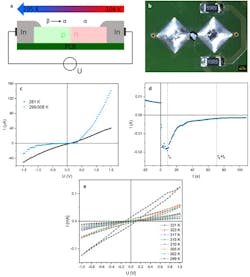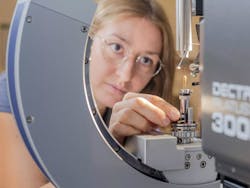To Be or Not to Be a Diode? It Depends on Temperature Gradient
What you’ll learn:
- How an advanced material can become both p- and n-material based on temperature gradient.
- The process by which this material was discovered and enhanced.
- The possible applications of this device technology.
Electrical and electronic circuits as we have them wouldn’t exist without the humble diode. Even before our modern solid-state diodes, engineers used crude but effective, now-obsolete selenium rectifier and even vacuum-tube diodes. Although their nominal function is simple—to allow current to flow in one direction only—the actual role that diodes have in circuits is much more varied and creative.
The semiconductor diode, constructed of p- and n-doped materials, has a well-known temperature dependence in its current-voltage relationship—a characteristic that can adversely affect circuit performance but also be exploited to create useful functions such as precision temperature sensors. Either way, one attribute shared by all diodes is that they function as diodes until reaching catastrophic breakdown or outright failure.
But perhaps the “once a diode, always a diode” aspect doesn’t have to be so. A research team at the Technical University of Munich (TUM) discovered a material that makes it possible to create a component which reversibly transitions between diode and non-diode via a simple change in temperature gradient.
“We have now found a material which we can cause to be n-conducting or p-conducting simply by changing the temperature,” said Tom Nilges, professor of Synthesis and Characterisation of Innovative Materials at TUM.
Material Evidence
The researchers have been able to show that a temperature change of just a few degrees is enough to bring about this effect, and that a functioning diode can be created with a temperature gradient within the material. When the material is at room temperature, it’s a normal p conductor. When a sufficient temperature gradient is applied, an n conductor is simultaneously generated in the heated areas. If the gradient falls below a threshold, the diode action ceases. An important aspect for potential applications is that the effect functions in room temperature range, with a local temperature rise of just a few degrees, from 22 to 35°C.
The search for the perfect material involved 12 years of work, culminating in the team’s discovery and in-depth investigation of metal chalcogenide halide Ag18Cu3Te11Cl3. It consists of the elements silver, copper, tellurium, and chlorine. The researchers came across this class of compounds when exploring thermoelectric materials.
One material they studied displayed the p-n switching effect. However, this was observed only in the temperature range around 100°C, which is unsuitable for practical applications. After extensive analysis and experimentation, the researchers discovered that Ag18Cu3Te11Cl3 displays the desired effect and is suitable for applications at more normal temperatures (Fig. 1).
1. Diode fabrication and U/I characterization (“U” is the German designation for volts): (a) Scheme of the measurement set-up. (b) Single crystal of Ag18Cu3Te11Cl3 mounted on top of Au electrodes and contacted with metallic In. The 49-Ω resistances used to apply a temperature gradient via resistivity heating can be found next to the right contact. (c) U/I plot measured at 281 K within b- Ag18Cu3Te11Cl3 (black line) and after applying temperature to the system to create a gradient of 13 K between 295(1) and 308(1) K (blue line). (d) Switching time of the diode under the same thermal gradient. A 5-V forward was applied, followed by a –5-V reverse current at t = 0. (The errors of the measured values are located within the points. (e) To ensure that no Schottky diode is being formed in the applied temperature ranges, they also measured isothermal U/I curves for Ag18Cu3Te11Cl3 up to 331 K. When the entire crystal was held at the same temperature, no rectifying characteristic was found. A conductivity increase was seen at higher temperatures as is expected for a semiconductor. (The errors of the measured values are located within the points.)
Applications—If Any
An obvious question is this: What are the possible applications for this morphable diode? Then answer is easy: It’s unclear. The authors speculate about possibilities, but they are very tentative and vague. As the next step, the researchers intend to show that their material can be used to create transistors through temperature changes. Then, with appropriate design, a single device could function as a resistance, a diode, or a transistor, depending on the temperature gradient and the position of the connections.
Of course, it’s easy to dismiss this development as having no viable applications, at least as of yet. Often, though, fundamental advances that seem to have no application eventually do so. Someone figures out how to adopt and adapt it to solve problems or implement functions that weren’t even conceived. Note that when Theodore H. Maiman demonstrated the first optical laser in 1960, journalists were impressed. However, some also derisively dismissed it as a “solution looking for problems to solve”—and we know how the laser story went after that.
In addition to the theoretical analysis, extensive tests were performed across a wide array of electrical, physical, chemical, crystal diffraction, and other parameters (Fig. 2).
2. Lead researcher and author Anna Vogel mounting a crystal on the single-crystal diffractometer to measure some of the device’s characteristics. In front of her is the glass capillary on which a 2-mm diameter crystal is placed.
The material science and physical chemistry is detailed—and I do mean detailed—in their deep-diving, 30-page, technically intense paper with the surprisingly short title “A Switchable One-Compound Diode,” published in Advanced Materials. In addition, they have added a 31-page Supporting Information file that goes even further into the physical structure and characteristics.
About the Author

Bill Schweber
Contributing Editor
Bill Schweber is an electronics engineer who has written three textbooks on electronic communications systems, as well as hundreds of technical articles, opinion columns, and product features. In past roles, he worked as a technical website manager for multiple topic-specific sites for EE Times, as well as both the Executive Editor and Analog Editor at EDN.
At Analog Devices Inc., Bill was in marketing communications (public relations). As a result, he has been on both sides of the technical PR function, presenting company products, stories, and messages to the media and also as the recipient of these.
Prior to the MarCom role at Analog, Bill was associate editor of their respected technical journal and worked in their product marketing and applications engineering groups. Before those roles, he was at Instron Corp., doing hands-on analog- and power-circuit design and systems integration for materials-testing machine controls.
Bill has an MSEE (Univ. of Mass) and BSEE (Columbia Univ.), is a Registered Professional Engineer, and holds an Advanced Class amateur radio license. He has also planned, written, and presented online courses on a variety of engineering topics, including MOSFET basics, ADC selection, and driving LEDs.


